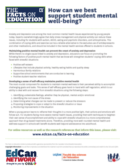How can we create conditions for Aboriginal student success in our public schools?
Aboriginal children under age 14 make up 7% of all children in Canada and the Aboriginal population is the fastest growing demographic in this country. Eighty percent of Aboriginal children attend off-reserve provincial schools. In terms of school success, there are significant gaps in learning outcomes and graduation rates between Aboriginal and non-Aboriginal students.
Nationally, provincially, and territorially, public school educators are committed to closing these gaps, and some success has been realized. For example, in classrooms where Aboriginal content and perspectives were incorporated into a high quality learning program, Aboriginal student grades increased significantly.
Strong leadership is critical to the development of high quality learning programs designed to provide Aboriginal students with every opportunity to succeed in Canadian public schools. Key strategies in creating environments to ensure this success include:
- Relationship building between the Aboriginal community and public school system administrators/educators and meaningful engagement of the Aboriginal community (Elders, Traditional Teachers, etc.) in all aspects of education from policy-making to creating curriculum and resources
- Increasing the numbers of Aboriginal teachers who share their culture and can identify with Aboriginal students and vice-versa
- Creating school cultures where Aboriginal students feel respected and can experience a positive sense of belonging
- Understanding and incorporating Aboriginal perspectives of learning that is: holistic; lifelong; experiential in nature; rooted in Aboriginal languages, cultures, and spirituality; community based involving family, Elders and other community members
- Incorporating Aboriginal perspectives and learning resources into daily curricula for all students – both Aboriginal and non-Aboriginal – rather than presenting them as add-on materials or special topics for some groups only
- Providing teachers with authentic and culturally appropriate resources reflective of local Aboriginal communities and perspectives
- Requiring the inclusion of Aboriginal history and perspectives in teacher training and professional development activities to inform and shape teacher attitudes and instructional practices in classrooms.
With the shared commitment and collaborative effort of all stakeholders – Aboriginal communities; policy makers; administrators, teachers, parents, and students – we can create schools where all students, both Aboriginal and non-Aboriginal, can learn and succeed at high levels.
ADDITIONAL INFORMATION RESOURCES
Shared Learnings: Integrating BC Aboriginal Content K-10
http://www.bced.gov.bc.ca/abed/shared.pdf
TDSB Professional Library, Education of Aboriginal Students in Canada: Selected Current References, August 2012
http://ramott.files.wordpress.com/2012/08/aboriginal-education2012_delinked.pdf
Resources for Rethinking: Aboriginal Voices in the Curriculum http://resources4rethinking.ca/en/resource/aboriginal-voices-in-the-curriculum
Western Canadian Protocol for Collaboration in Basic Education: Aboriginal Languages and Culture Programs
http://www.education.gov.sk.ca/wncp-common-language-framework
Edmonton Public Schools
http://aboriginaleducation.epsb.ca/
Successful Transitions for First Nations, Métis and Inuit Students http://www.education.alberta.ca/media/6397158/successful%20transitions%20fnmi.pdf
Promising Practices in Aboriginal Education
http://www.maei-ppw.ca/
Ontario First Nation, Métis, and Inuit Education Policy Framework
http://www.edu.gov.on.ca/eng/aboriginal/OFNImplementationPlan.pdf
EXAMPLES OF SPECIFIC ABORIGINAL EDUCATION POLICIES
Ontario
Aboriginal Education Strategy
http://www.edu.gov.on.ca/eng/aboriginal/curricNSNL.html
Manitoba
Integrating Aboriginal Perspectives into Curricula http://www.edu.gov.mb.ca/k12/docs/policy/abpersp/index.html
Saskatchewan
Aboriginal Education Initiatives in Saskatchewan Education: 1995-1998 http://www.education.gov.sk.ca/Aboriginal-Education-Initiatives
Alberta
First Nations, Métis and Inuit Education Policy Framework February 2002
http://education.alberta.ca/media/164126/framework.pdf
British Columbia
Ministry of Education Aboriginal Education Policy
https://www.bced.gov.bc.ca/abed/
REFERENCES
Anuik, J., Battiste, M., George, N., & George, P. (2010). Learning from promising programs and applications in nourishing the learning spirit. Canadian Journal of Native Education, 33(1), 63-82.
Canadian Council on Learning. (2007). Redefining How Success is Measured in First Nations, Inuit and Métis Learning, Report on Learning in Canada. Ottawa, ON: Author
Canadian Council on Learning. (2009). The State of Aboriginal Learning in Canada: A Holistic Approach to Measuring Success. Ottawa, ON: Author.
Claypool, T.R., & Preston, J.P. (2011). Redefining learning and assessment practices impacting Aboriginal students: Considering Aboriginal priorities via Aboriginal and Western worldviews. In Education, 17(3), 84-95.
Council of Ministers of Education, Canada (CMEC, 2009). Strengthening Aboriginal success: Moving toward Learn Canada 2020 (Summary Report from the CMEC Summit on Aboriginal Education, February 24-25) Summit on Aboriginal Education Summary Report. Retrieved from:
http://www.cmec.ca/Publications/Lists/Publications/Attachments/221/aboriginal_summit_report.pdf
Friesen, J., & Krauth, B. (2012). Key policy issues in Aboriginal education: An evidence-based approach. Toronto, ON: Council of Ministers of Education, Canada.
Gallagher-Mackay, K., Kidder, A., & Methot, S. (2013). First Nations, Metis, and Inuit Education: Overcoming gaps in provincially funded schools. Toronto, ON: People for Education.
Howe, E. C. (2011). Bridging the Aboriginal education gap in Saskatchewan. Saskatoon, SK: Gabriel Dumont Institute. Retrieved from:
http://www.gdins.org/ckfinder/userfiles/files/Bridging_AbEduGap_GDI_final.pdf
Kanu, Y. (2011). Integrating Aboriginal perspectives into the school curriculum: Purposes, possibilities, and challenges. Toronto, ON: University of Toronto Press.
Mattern, A. (2013, Fall). The best is yet to come: Aboriginal teacher education programs thriving. Green & White: University of Saskatchewan Alumni Magazine, p. 22-23. Retrieved from: http://www.usask.ca/greenandwhite/issues/2013/fall2013/output/GandW.pdf
Richards, J. (2013). Why is BC best? The role of provincial and reserve school systems in explaining Aboriginal student performance (Commentary No. 390). Toronto, ON:C.D. Howe Institute. Retrieved from:
http://www.cdhowe.org/pdf/Commentary_390.pdf
Richards, J., Hove, J, Afolabi, K. (2008). Understanding the Aboriginal/non-Aboriginal gap in student performance: Lessons from British Columbia. Toronto, ON: C. D. Howe Institute.
Richards, J., & Scott, M. (2009). Aboriginal education: Strengthening the foundations. Canadian Policy Research Networks. Retrieved from:
http://cprn.org/documents/51984_EN.pdf
Riley, T., & Ungerleider, C. (2012). Self-fulfilling prophecy: How teachers’ attributions, expectations, and stereotypes influence the learning opportunities afforded aboriginal students. Canadian Journal of Education, 35(2), 303-333.
Statistics Canada. (2013). Aboriginal Peoples in Canada: First Nations People, Métis and Inuit (Catalogue no: 99-011-X2011001). Ottawa, ON: Ministry of Industry.
Thomas, D.M. (2005). Incorporating Aboriginal content and perspectives in Saskatchewan curricula: Experiences of selected teachers. Unpublished Master’s Thesis, University of Saskatchewan. Retrieved from:
Toulouse, P.R. (2011). Achieving Aboriginal student success: A guide for K to 8 classrooms. Winnipeg, MB: Portage and Main. Retrieved from:
https://www.portageandmainpress.com/lesson_plans/plan_303_1.pdf
Toulouse, P.R. (2008, March). Integrating Aboriginal Teaching and Values into the Classroom. What Works? Research into Practice #11.
http://www.edu.gov.on.ca/eng/literacynumeracy/inspire/research/Toulouse.pdf

